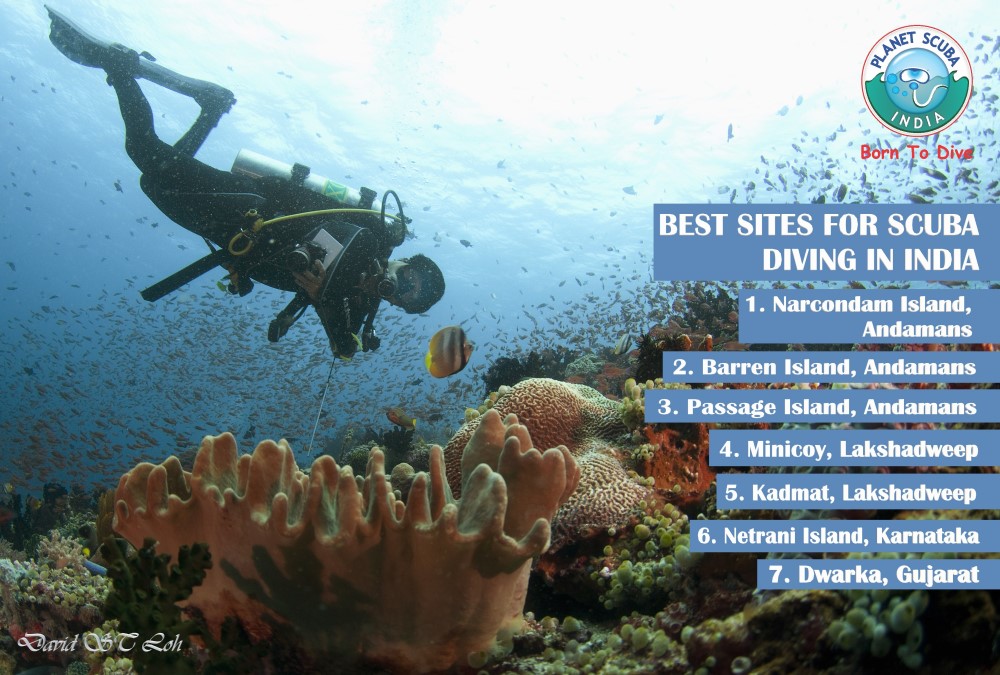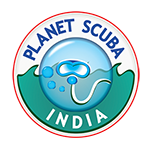
Here are seven of the best sites for scuba diving in India Planet Scuba India recommends that should be on your bucket list this year. Scuba diving in India has explored less than one per cent of the country’s more than 8,000 km coastline. By virtue of their geography, the archipelagos of Lakshadweep and Andaman and Nicobar are the gems of world class diving. Followed close on their heels by Dwarka. The lost city of legend that could well rewrite history as we know it! And then, there is the heart-shaped island in Karnataka. Adored by divers for its tranquil waters and rich marine life. From whale shark sightings to macro photography, scuba diving in India offers a plethora of options, for both beginners as well as advanced divers.
1. Narcondam Island, Andamans
Ooh La La—a quirky name for a site for scuba diving in India. But then, everything about Narcondam prompts the expression. Located around 256 km to the northeast of Port Blair, this volcanic island in the Andamans is covered in dense forests. Its lush green peak that rises from brilliant blue waters forms a rather picturesque contrast. But it is the panorama below the waves that interests scuba diving enthusiasts. Especially since it was none other than the father of scuba diving, Jacques Cousteau, who put this island on the diving map.
Scuba diving sites: Ooh La La and Lighthouse Reef. These scuba diving sites at Narcondam feature rocky ledges and steep slopes. These are replete with colorful hard and soft coral, huge barrel sponges and large sea fans. The clear waters offer visibility of up to 25 meters. Depths here exceed 30 meters.
Marine attractions: Schools of bumphead parrotfish, surgeonfish, fusiliers, snappers, angelfish and a variety of brightly hued reef fish. The deep waters also increase sightings of pelagics. Yes, one can expect to see manta rays, eagle rays, Napoleon wrasses, tunas, big-eyed travellies and grey reef and whitetip sharks.
2. Barren Island, Andamans
Scuba diving near an active volcano! The mere thought is enough to give you an adrenaline rush. Now couple that with the fact that the volcano dates back 1.6 million years. Packed your diving gear yet?! Barren Island in the Andamans lies on the edge of the India-Burma tectonic plates. And has earned a reputation worldwide for having some of the best sites for scuba diving in India. The underwater world here is a series of juxtapositions: clear blue waters, dark black soil and colorful reef life. Not to forget that surface intervals offer splendid sights of a smoking volcano.
Scuba diving sites: Purple Haze. Thus named to reflect a 50-meter-wide area covered in soft purple corals. Black Magic has sand divers and moray eels peeking out of a bed of black sand. Other scuba diving sites here include Manta Point, Coral Garden, Auditorium & Gallery and Manta Bay. You can spot that manta ray circling 25 meters away. Most dive sites have depths of more than 30 meters.
Marine attractions: Manta rays! Yes, we know we mentioned them already. Moray eels, turtles, octopus, whitetip and blacktip sharks. Also, barracudas, travellies, dogtooth tuna, needlefish, parrotfish, and a multitude of reef fish. Oh, and whale sharks are occasionally spotted at some of the dive sites here too.
3. Passage Island, Andamans
High on our list of best sites for scuba diving in India is the uninhabited Passage Island. Here the waters attract pelagics aplenty! Located about 53 km south of Port Blair, this island boasts an offshore pinnacle called Fish Rock. A scuba diving site that, true to its name, is teeming with fish life.
Scuba diving sites: Barrel sponges, large orange fan corals and clusters of soft corals cling to the rocky reef of Fish Rock. This dive site slopes down to more than 30 meters.
Marine attractions: Bumphead parrotfish crunch on corals. While barracudas and surgeonfish swirl around in schools. Yellowback fusiliers, bluestripe snappers and bannerfish paint the waters in their vibrant hues. Moray eels peek out from under rocks. The bolder ones, at times, can be seen draping themselves on fan corals. Also making an appearance are groupers, turtles, rays, Napoleon wrasses and dogtooth tuna.
4. Minicoy, Lakshadweep
Every diver we know of gets all dreamy-eyed about scuba diving in the Maldives. Enter Minicoy, the island located at the southernmost tip of the Lakshadweep archipelago. Which is just an Eight Degree Channel separation from the Maldives, as per the Admiralty Charts. Minicoy offers the most spectacular sites for scuba diving in India. Not least of which are the three large shipwrecks at around 8 meters depth on the island reef. Allegedly, it was these shipwrecks that lead to the construction of the lighthouse on the island in 1885. Other tourist attractions on this crescent-shaped island include the large lagoon on the western side and the tiny islet on the southern tip called Viringili.
Scuba diving sites: The SS Hoechst and other shipwrecks are best described as underwater museums. Not least because they are home to a large number of fish species. Manta rays can be spotted at dive sites like Ragganmathi, Mulimatti and Rabberufarai during September and October. While Bose Point, Murambu and Boduhavaligang offer great marine biodiversity.
Marine attractions: Whitetip and blacktip sharks, rays, turtles, jacks, barracudas, tuna, sweetlips, large groupers, red snappers, black snappers, bigeye trevallies, Napoleon wrasse, humphead parrotfish… The list simply goes on and on.
5. Kadmat, Lakshadweep
This idyllic island in the Lakshadweep archipelago is just 8 km long and 550 m wide. That too at its broadest point! Kadmat promises one of the most memorable holidays for scuba diving in India. Thanks to its shallow calm lagoon, pristine beaches, crystal clear waters and rich marine life.
Scuba diving sites: The Wall, covered with soft corals, is one of the most beautiful reefs. Schools of tuna and barracuda vie for your attention. While sharks whiz past and turtles swim by at a languid pace. Other dive sites here are North Cave, Potato Patch and Shark Alley. Visibility in these waters ranges from 20 to 50 meters.
Marine attractions: Sharks, eagle rays, turtles, tunas, jacks, sweetlips, groupers, moray eels, lobsters, batfish, fusiliers, wrasses… The dive sites here are great for macro photography too.
6. Netrani island, Karnataka
The heart-shaped island is possibly one of the most adorable destinations for scuba diving in India. Netrani, located off the coast of Karnataka, is a small, uninhabited island. A rocky outcrop emerging from the Arabian Sea, approximately 10 nautical miles from Murudeshwar. The temple town that is home to the second largest Shiva statue in India. It is rated as one of the best places on the west coast for scuba diving in India. Mostly because the tranquil waters here are known to throw up unexpected surprises.
Scuba diving sites: The Nursery teems with juvenile fish of various species. While T55 is a great place to spot groupers, travellies, jacks and a sunken torpedo. Grand Central Station, The Abyss, Dini’s Delight, Cul de Sac and Aladdin’s Cave round up the list of scuba diving sites at Netrani. The clear waters offer visibility of 15 to 30 meters. Depths range from 10 to more than 30 meters.
Marine attractions: Butterflyfish, barracudas, batfish, groupers, parrotfish, surgeonfish and snappers dart into camera range. At The Abyss, cruising pelagics are a common sight. The seagrass at Cul de Sac is home to different species of goby and their cleaner shrimp.
7. Dwarka, Gujarat
Imagine scuba diving in India at a place that could rewrite world history. We are talking about the over 9,000-year-old lost city of Dwarka! The legendary dwelling place of Lord Krishna. For this reason, Dwarka finds its place on the our list of the best sites for scuba diving in India. While findings by the Underwater Archaeology Wing of the Archaeological Survey of India only reveal that ancient structures have been discovered, along with 30 copper coins. The exact date of the structures and coins are yet to be discerned.
Scuba diving sites: Tall sea sea fans, hydroids, sea anemones, the underwater city offers a varied collection of corals.
Marine attractions: To think that whale sharks can be spotted so close to home. Oh, and turtles and dolphins sightings are common in the Gulf of Kutch. You can also expect to spot octopus, pufferfish and other species during low tides at the marine sanctuary here.
